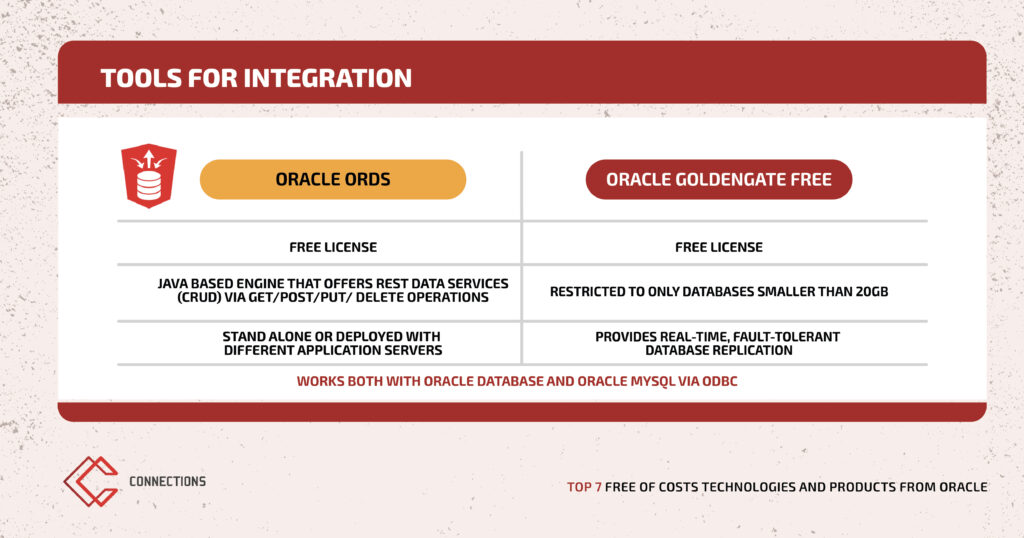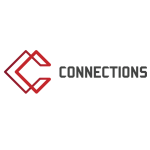A presentation delivered by Ciprian Onofreiciuc, at Dev Talks 2024
The Big Data & Cloud stage at Dev Talks, an event where Connections served as the Tech Area Partner, hosted a compelling presentation by our colleague, Ciprian Onofreiciuc, Oracle Architect, on a topic of interest to all involved in software development and IT architecture: “What’s free in Oracle? – Top 7 free technologies and products from Oracle”.
During his presentation, Ciprian highlighted seven free technologies and products offered by Oracle that are revolutionizing how developers and companies approach the technological landscape.
HERE ARE THE TOP 7 FREE TECHNOLOGIES AND PRODUCTS FROM ORACLE:
- Oracle VM VirtualBox
A versatile tool, free and open-source software that allows users to run multiple operating systems on a single computer, a great option for both personal and professional use.
It can be used for:
- Software development and testing: Developers can test their applications on different operating systems.
- System administration: IT professionals can simulate network environments for configuration testing.
- Education and training: Students can learn and practice using different operating systems.
- Support for legacy applications: Run older software that may not be compatible with newer.

Oracle VM is a virtualization solution that meets the needs of data centers seeking a high-performance, scalable, and reliable solution.
ADVANTAGES:
High performance and scalability:
- Supports up to 384 physical CPUs and 6TB of memory
- Supports a wide range of host operating systems
High reliability and availability:
- Secure live VM migration.
- Live storage migration of VMs.
- High availability.
Management:
- Faster software deployment with Oracle VM templates.
- Support for virtual appliances: OVF format, OVA format.

6. Oracle Linux: Optimized OS for Oracle Products
An excellent choice for companies relying on Oracle products and seeking a secure and reliable operating system.
Key benefits:
- Optimized performance: Smooth operation of Oracle software, including databases and enterprise applications.
- Stability and reliability: Built on a solid foundation (Red Hat Enterprise Linux) and rigorously tested to ensure a stable and reliable system.
- Security: Includes integrated security features and receives regular updates to keep your system protected.
- Cost-efficient: Free to download and use, with optional support subscriptions available.

- Database Management Systems – Oracle Database 23ai Free vs. Oracle MySQL 8.4
Two popular Database Management Systems, each with its own strengths and occasional limitations. Choosing the most suitable one depends on the specific needs of your project.
- Oracle Database 23ai Free: A free version of Oracle Database, offering a perpetual license with certain resource limitations. Ideal for personal projects, learning, testing, and prototyping.
- Oracle MySQL 8.4: A popular open-source database known for its scalability, performance, and reliability. An excellent choice for production environments requiring efficient large-scale data management.

4. Oracle SQL Developer vs. MySQL Workbench: choosing the right tool for Database Development and Administration
Both Oracle SQL Developer and MySQL Workbench are powerful tools for database development and administration, but each has different strengths. Here’s a quick comparison to help you choose the right tool:
- Oracle SQL Developer: Optimized for Oracle databases but can also work with other relational databases (requires additional connectors).
- MySQL Workbench: Designed specifically for MySQL, but can also manage other relational databases with limited support.

3. Oracle Integration Tools: ORDS vs. GoldenGate Free
Both Oracle ORDS and Oracle GoldenGate Free are free tools provided by Oracle for integration, but they serve different purposes.
- Choose ORDS if:
- You need to quickly expose data as RESTful web services for your applications.
- Your database size is under 20 GB.
- Choose GoldenGate Free if:
- You need to replicate data in real-time between Oracle or MySQL databases.
- You want error tolerance and continuous data synchronization.

- Oracle APEX
A low-code development platform that allows building web applications with minimal programming. It’s free with an Oracle Database license and offers advantages such as:
- Easy to learn and use, even with limited programming experience.
- Rapid application development for time and resource savings.
- Scalable to adapt to your business needs.
- Secure to protect data.
- Accessible from mobile devices.
- Extensible through custom code.
- Active developer community for support.

- Oracle Cloud Free Tier Service
The Oracle Cloud Free Tier offers users free access to a variety of essential cloud services, including AMD and Arm-based virtual machines, block and object storage solutions, and autonomous databases. These free services are available for an unlimited period, allowing users to experiment with and use Oracle technologies without initial costs.

Thus, the free technologies and products from Oracle are not just a collection of tools, but rather a source of opportunities for those passionate about innovation in the technology field. From virtualization and database management solutions to low-code development platforms and cloud services, Oracle puts accessibility and performance at the forefront. To further explore this universe of possibilities, we invite you to access the links above and venture into the world of Oracle technologies.
Virtualization
- Oracle Virtual Box – https://www.virtualbox.org/wiki/Licensing_FAQ
- Oracle VM Server for x86 – https://www.oracle.com/a/ocom/docs/ovm-server-for-x86-459312.pdf
Operating Systems
Database Management System
- Oracle Database 23AI FREE – https://www.oracle.com/downloads/licenses/oracle-free-license.html
- Oracle MySQL – https://www.mysql.com/about/legal/licensing/oem/
TOOLS FOR DATABASE DEVELOPMENT AND ADMINISTRATION
- Oracle SQl Developer – https://www.oracle.com/database/technologies/appdev/sqldev/sql-developer-faq.html
- Oracle MySQL WorkBench – https://downloads.mysql.com/docs/licenses/workbench-8.0-com-en.pdf
TOOLS FOR INTEGRATION
- Oracle ORDS – https://www.oracle.com/tools/technologies/faq-rest-data-services.html
- Oracle Golden Gate – https://docs.oracle.com/en/middleware/goldengate/core/21.3/ogglc/licensing-information.html#GUID-AFD634A9-97A1-49A9-A04F-427070FB143D
Application Framework
Cloud
- Oracle Cloud Free Tier – https://www.oracle.com/cloud/free/#free-cloud-trial
Free, but with significant benefits
These free solutions come with numerous essential advantages:
- Savings: using these free products can bring significant savings by eliminating expenses related to licenses or other associated costs.
- Flexibility: free products allow for flexible adoption and usage, giving companies the ability to test and implement solutions without major financial constraints.
- Community: many of these free solutions are supported by large communities, providing support, updates, and continuous innovation.
- Transparency and security: most free products, especially open source ones, offer full code transparency, allowing for security audits and customizations.
- Avoidance of vendor lock-in: using these free solutions can prevent being locked into a specific vendor’s ecosystem, offering the freedom to switch solutions as needed.
- Support: while varying, free products generally benefit from community or vendor support, providing a minimum level of assistance and guidance.
Ciprian also highlighted the essential differences between terms such as “free,” “zero license cost,” and “freeware” in the software industry, emphasizing that understanding these is crucial for making informed decisions.
- Free (Free of Cost): software labeled as “free” does not require payment for use, which can significantly reduce expenses.
- Zero License Cost: software with zero license cost does not require a license fee, but there may be other costs, such as support or premium features.
- Freeware: software distributed for free but with proprietary licensing. Usage is free, but there may be restrictions on modification, redistribution, or commercial use.
- Open Source vs. Freeware: open-source software can be free but offers different freedoms compared to freeware, including modification and redistribution.
CIPRIAN ONOFREICIUC: AN EXPERT IN ORACLE TECHNOLOGIES
Ciprian Onofreiciuc, Oracle Architect, has built an impressive career in the technology field, accumulating twenty years of experience in software development, project management, IT architecture, and service operations. With his vast expertise and passion for innovation, Ciprian has become a reference point in the industry, making significant contributions to technological advancement and the development of the professional community.






















